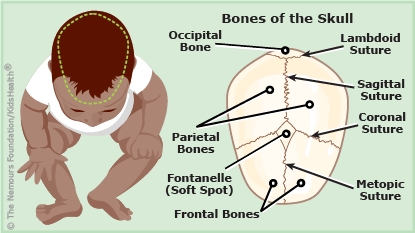At birth, babies have fibrous joints called sutures that hold the skull bones together. The sutures can squeeze together during childbirth but also can get bigger to give the brain room to grow. Over the next 20 years or so, the sutures close, forming the hard bones of the skull.
Craniosynostosis (kray-nee-oh-sin-oss-TOE-sis) happens when one or more of the sutures closes too soon, usually either before birth or in the first few months of life. This can change the shape of the head and face and cause other medical problems when the brain doesn't have enough room to grow.
Babies with craniosynostosis are treated by a care team of medical specialists. Surgery in the first year of life helps to reshape the head and face and gives the brain room to grow.


Follow your health care provider's advice for:

Your child has new or worse symptoms, such as vomiting, extreme tiredness, or unusual movements of the eyes (these can be signs that the brain doesn't have enough room to grow).
You know your child best. Call your health care provider or someone on the care team if your child has signs that worry you.

What causes craniosynostosis? It's not always clear why a child has craniosynostosis. When only one suture closes early, it usually just happens by chance. If more than one suture closes early or there are other birth differences (such as heart problems or fingers or toes that look different), the craniosynostosis may be from a genetic disorder.
What problems can happen if craniosynostosis isn't treated? If the shape of the head and face aren't corrected with surgery, these changes can be permanent. Also, without treatment, craniosynostosis can lead to increased pressure inside the skull. This happens when the skull can't get big enough to fit the growing brain. Increased pressure inside the skull can cause developmental problems, headaches, brain damage, seizures, or blindness.
Is craniosynostosis the same as flat head syndrome (positional plagiocephaly)? No, flat head syndrome happens when a baby keeps their head turned in the same direction while sleeping. It is not caused by the sutures closing early. Although flat head syndrome can cause changes in the shape of the head (and sometimes the face), the brain has space to grow normally. Also, babies with craniosynostosis almost always need surgery, while babies with flat head syndrome usually just need simple at-home exercises.